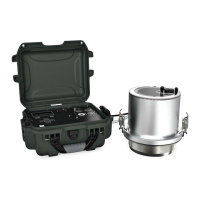20
SYSTEM
This approach overestimated K
fs
due to lateral divergence of flow resulting from the
capillarity of the unsaturated soil and from the ponding in the ring (Bouwer 1986). Attempts
to eliminate flow divergence involved the addition of an outer ring to buffer the flow in the
inner ring (Figure30). However, the double-ring infiltrometer technique was ineffective at
preventing lateral flow from the inner ring (Swartzendruber and Olson 1961a, 1961b).
cylinder
Mariotte
cylinder
Wetting
front
cylinder
D
Water
b
d
Figure30 Cross section of a double-ring infiltrometer
More recent research provides new methods for correcting for lateral flow. Reynolds
and Elrick (1990) presented a new analysis method of steady ponded infiltration into
a single ring, which accounts for soil capillarity, depth of ponding, ring radius (b), and
depth of ring insertion (d) and provides a means for calculating K
fs
, matric flux (φ
m
), and
macroscopic capillary length (∝). This analysis is known as the two-ponding head approach
(Reynolds and Elrick 1990).
The two -ponding head approach is the technique used by SATURO, though with some
modifications and simplifications. The easiest equation for this calculation is from
Nimmo et al. (2009). They compute K
fs
as shown in Equation 1
K
fs
=
Equation 1
where i (cm/s) is the steady (final) infiltration rate (volume divided by area) and F is a
function that corrects for sorptivity and geometrical effects.

